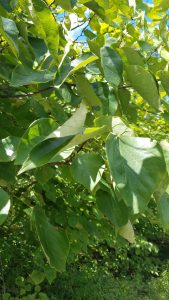This article was submitted by Kim Erndt-Pitcher, Habitat and Agricultural Programs Specialist at Prairie Rivers Network. Kim can be reached at [email protected].
The warm weather is arriving! While you are getting ready to plant, weed, and harvest the fruits of your labor, when you pause to taste some spinach, smell a flower, or watch a bee, please take a moment to look up at your trees. The last few years, many trees and other broadleaf plants throughout Illinois expressed symptoms of off-target herbicide damage. This was likely the result of exposure to volatile plant growth regulator (PGR) herbicides such as dicamba and/or 2, 4-D that are used for weed control on row crop ag fields.
When these PGR herbicides volatilize, they can move long distances and land other places at concentrations strong enough to harm trees and plants. While label restrictions are being made to reduce injuries and complaints due to applicator error, the real problem with many PGR herbicides (volatility) is not being addressed.
 Stunted, curled, and/or cupped leaves are some of the more obvious signs of potential off-target herbicide injury. Redbuds, dogwoods, sycamores, oaks, and box elder are among the many trees that have shown symptoms. Also, many native wildflowers and important food crops such as fruit trees, tomatoes, and grapes, have been shown symptoms of herbicide damage. To see photos of plants exhibiting the typical symptoms of herbicide damage see the Prairie Rivers Network (PRN) website (link below).
Stunted, curled, and/or cupped leaves are some of the more obvious signs of potential off-target herbicide injury. Redbuds, dogwoods, sycamores, oaks, and box elder are among the many trees that have shown symptoms. Also, many native wildflowers and important food crops such as fruit trees, tomatoes, and grapes, have been shown symptoms of herbicide damage. To see photos of plants exhibiting the typical symptoms of herbicide damage see the Prairie Rivers Network (PRN) website (link below).
PRN, and our partners are working hard to keep these harmful herbicides from harming you, your crops, local specialty growers with orchards and organic farms, and our environment. We realize that many people don’t even know what symptoms of herbicide injury look like and where to report injuries. However, this information is critical to our ability to push for protections against harmful chemicals.
You can do two things! If you see damage, we ask that you please let us know through our online monitoring form. Information can be found on our website http://prairierivers.org/resources/monitoring-tree-and-plant-health/. If you have a google account, you can upload your photo and document what you see in just a few minutes by using our online form at www.prairierivers.org/report. The more we know about when and where symptoms of injury are occurring, the better we can protect our environment.
Additionally, we also ask that if you suspect herbicide damage please fill out a complaint form on the Illinois Department of Ag (IDOA) website https://www2.illinois.gov/sites/agr/Pesticides/Documents/pesticidemisusecomplaintform.pdf#search=pesticide%20misuse%20form. We urge you to do this, even if you live in the middle of town! Reporting damage to IDOA is important. They use the complaint information to make regulatory and enforcement decisions.
We can all do our part to protect specialty growers, wildlife habitat, and our precious trees from these volatile herbicides. You can do your part by reporting symptoms using our monitoring program and by filing a complaint with IDOA.


